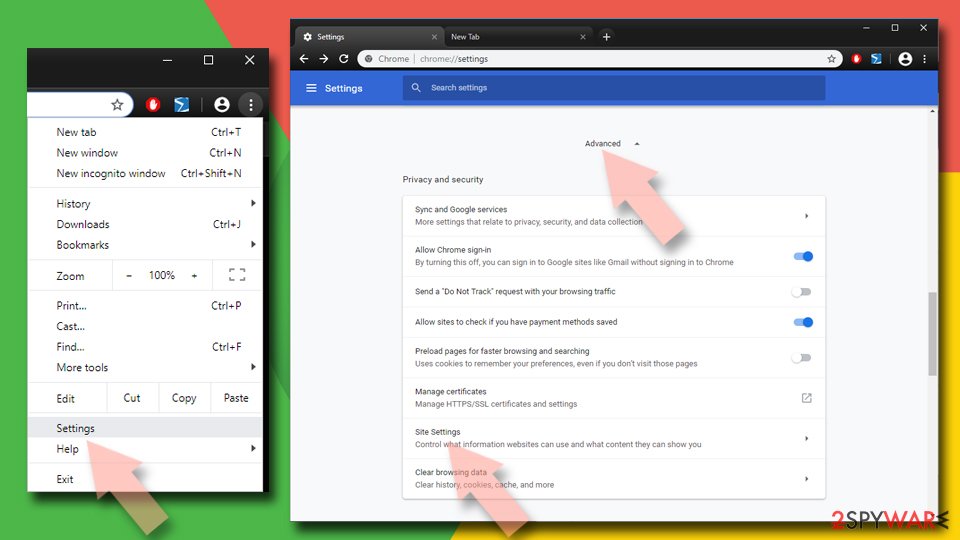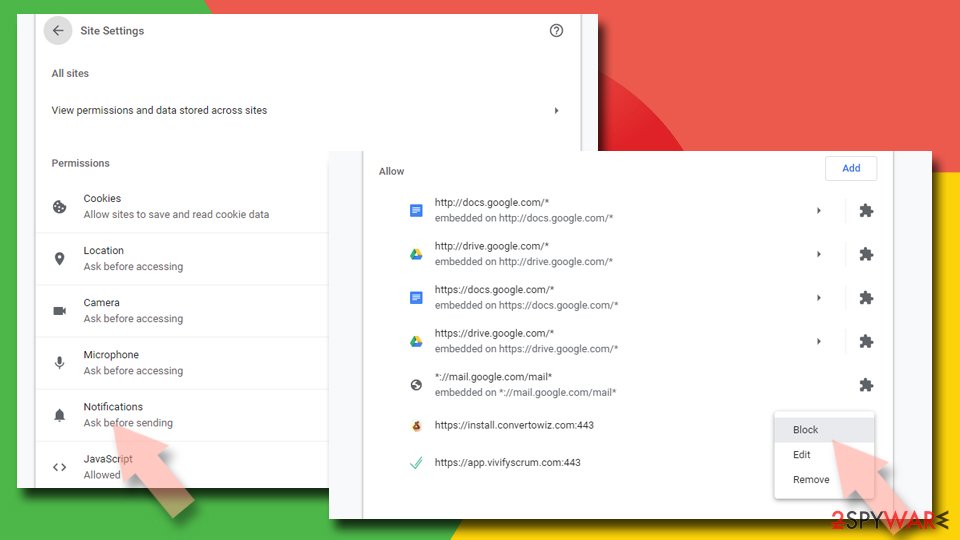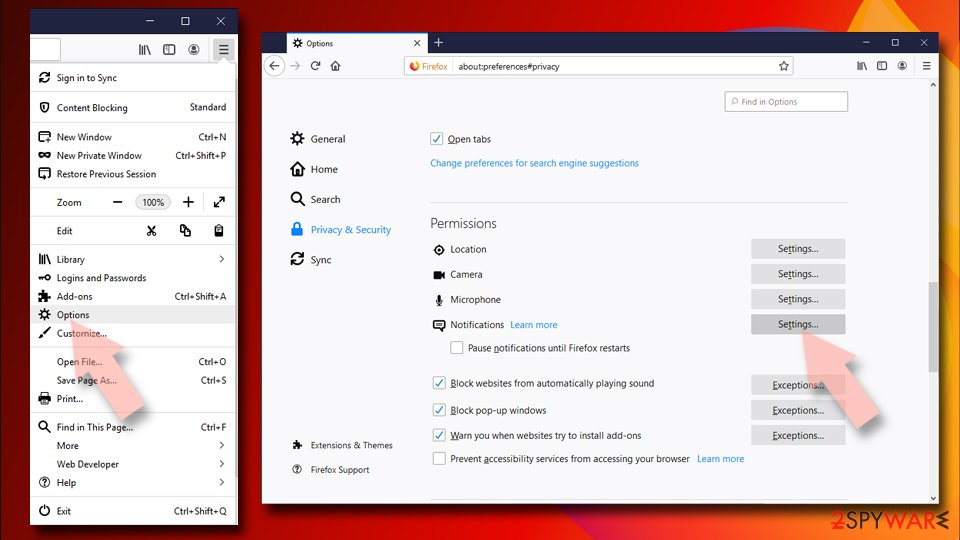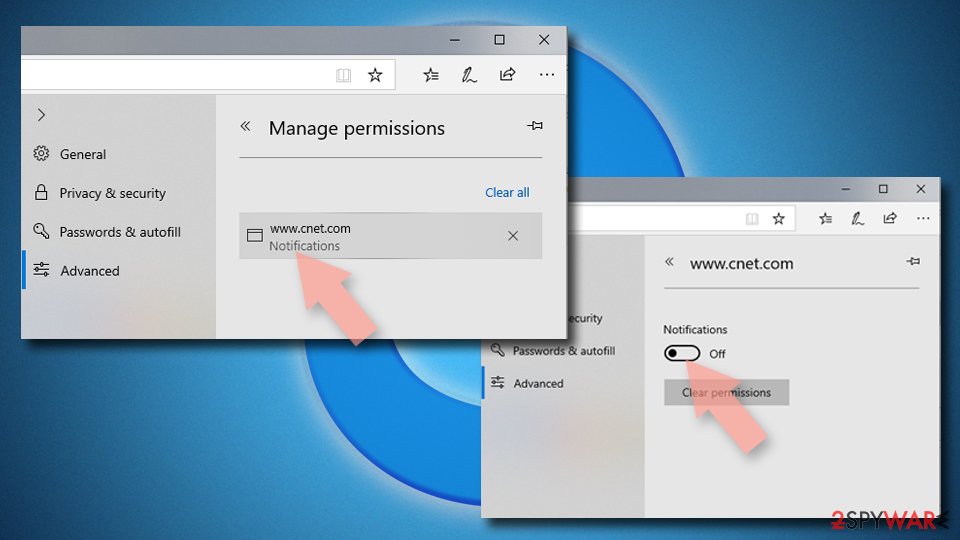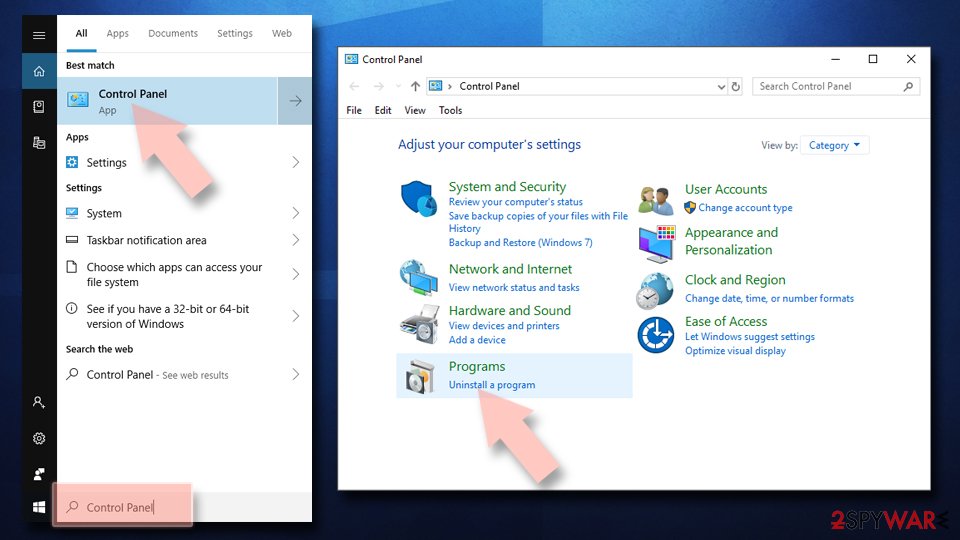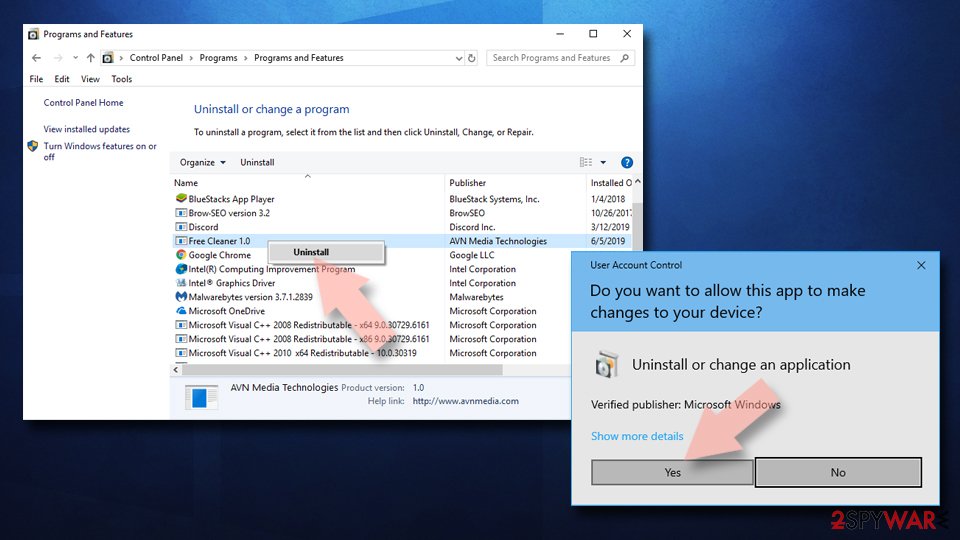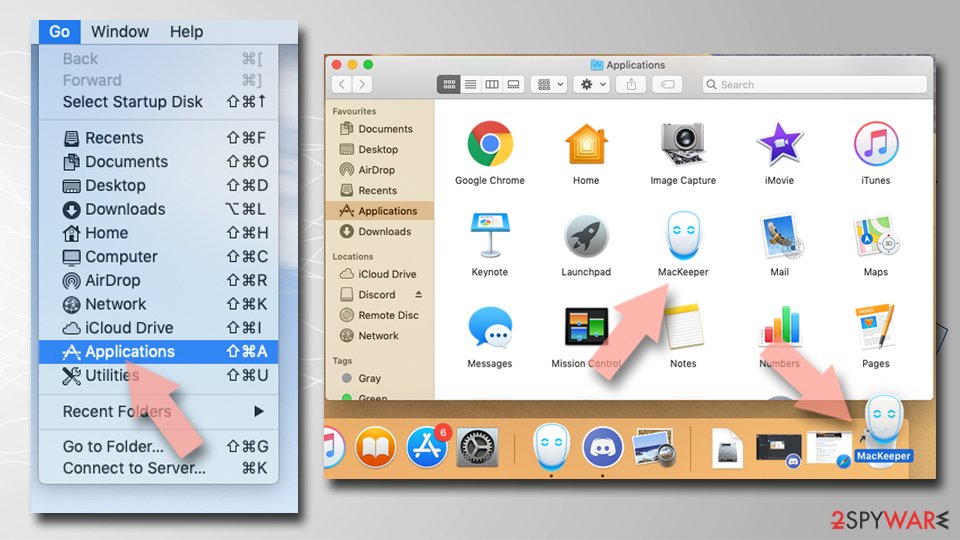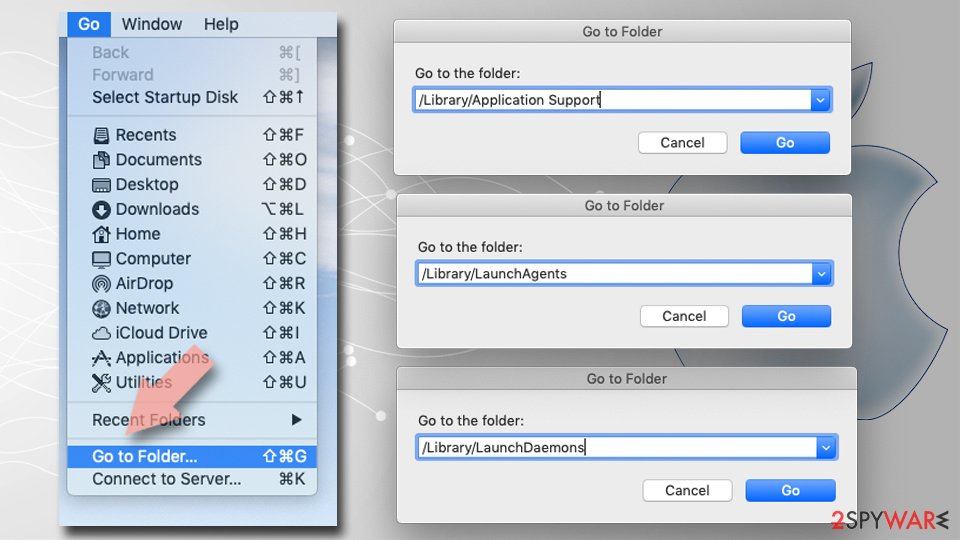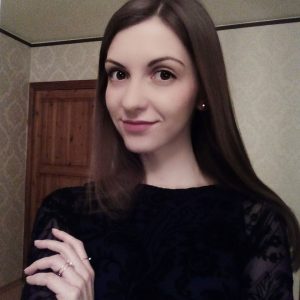Syscod.xyz ads (fake) - Free Instructions
Syscod.xyz ads Removal Guide
What is Syscod.xyz ads?
Syscod.xyz is a bogus site created by crooks to mimic McAfee Security alerts
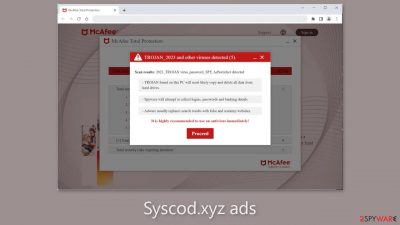
Despite the fact that Syscod.xyz may look like a McAfee security alert, it's crucial to know that McAfee is not connected to this misleading effort. The crooks are merely using the McAfee name to gain credibility. These fraudsters use social engineering techniques to trick visitors to this website into believing that their system has been compromised.
The website even displays a fabricated system scan animation. It's important to keep in mind that websites are unable to do actual system scans. The main goal of this technique is to direct users to the official McAfee website so that the fraudsters can profit from any subscriptions that are made through the affiliate program.
| NAME | Syscod.xyz |
| TYPE | Push notification spam, adware |
| SYMPTOMS | Users may start seeing pop-ups that say their system is infected; the amount of commercial content on the machine might increase |
| DISTRIBUTION | Shady websites; deceptive ads; freeware installations |
| DANGERS | The website may cause unnecessary installations of antivirus programs or cause pop-ups leading to shady sites |
| ELIMINATION | Check your browser for malicious browser extensions, and scan your machine with anti-malware tools; follow our guide for push notification removal instructions |
| FURTHER STEPS | Use FortectIntego to clear your browsers and get rid of any remaining damage |
Distribution methods
It is uncommon to find Syscod.xyz-like pages in search results. They lurk more frequently on dubious, unregulated websites. For example, illegal streaming services are known for hosting deceptive adverts and sneaky redirects, frequently including fake “Download” and “Play” buttons.
If people visit such web pages and spot a notification that reads “TROJAN_2023 and other viruses detected (5),” it probably appears legitimate. It is advised to only go to well-known and reputable websites. Do not click on random links or advertising, even if they seem to promote trustworthy goods and services.
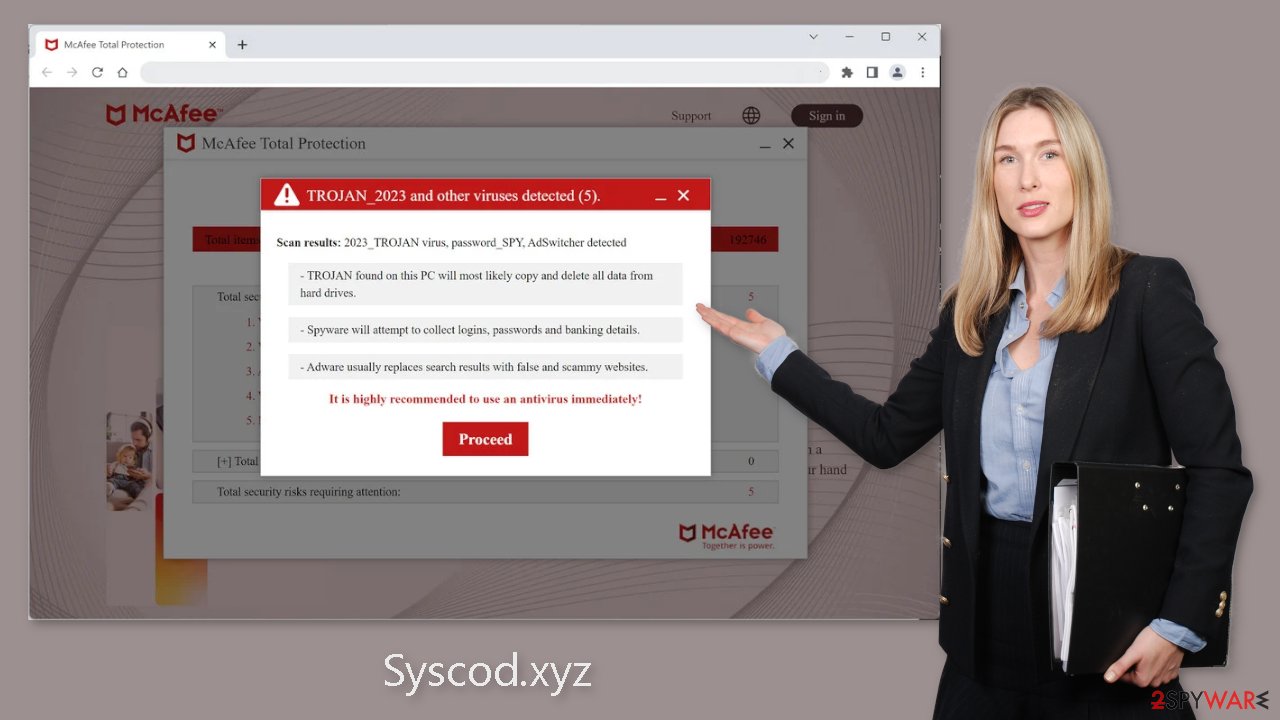
Adware explained
It's important to take into account the possibility that an adware[1] infection may have caused you to come across misleading websites. Adware is software supported by advertising that can generate pop-ups, banners, and redirects. These advertisements frequently come from rogue ad networks and direct users to risky websites where they are tricked into providing personal information, downloading potentially unwanted programs (PUPs),[2] and even downloading malware.
Check the browser for malicious extensions
Examine your browser to see if a browser hijacker has affected it. Modifications to the homepage, new tab URL, and search engine are just a few examples of altered settings that could be indicators of this. These browser hijackers have the ability to automatically redirect visitors to dubious websites like Syscod.xyz through web-based applications. As a result, it's a good idea to check your browser's settings for any new plugins. We advise disabling each of these plugins separately to see if any changes are made.
Clear your browsers
We advise using a FortectIntego restore utility to keep your web browsers healthy. Almost every website you visit uses cookies[3] to track your online behavior, including the pages you view, the links you click, and the things you buy. This data may be shared or sold to advertising networks and other third parties and used for commercial benefit.
Disable push notifications
To stop annoying virus alerts from Syscod.xyz, you have to block the site permissions that allow it to show push notifications. You can do that by following our step-by-step guide:
Google Chrome (desktop):
- Open Google Chrome browser and go to Menu > Settings.
- Scroll down and click on Advanced.
- Locate the Privacy and security section and pick Site Settings > Notifications.
![Stop notifications on Chrome PC 1 Stop notifications on Chrome PC 1]()
- Look at the Allow section and look for a suspicious URL.
- Click the three vertical dots next to it and pick Block. This should remove unwanted notifications from Google Chrome.
![Stop notifications on Chrome PC 2 Stop notifications on Chrome PC 2]()
Mozilla Firefox:
- Open Mozilla Firefox and go to Menu > Options.
- Click on Privacy & Security section.
- Under Permissions, you should be able to see Notifications. Click Settings button next to it.
![Stop notifications on Mozilla Firefox 1 Stop notifications on Mozilla Firefox 1]()
- In the Settings – Notification Permissions window, click on the drop-down menu by the URL in question.
- Select Block and then click on Save Changes. This should remove unwanted notifications from Mozilla Firefox.
![Stop notifications on Mozilla Firefox 2 Stop notifications on Mozilla Firefox 2]()
MS Edge:
- Open Microsoft Edge, and click the Settings and more button (three horizontal dots) at the top-right of the window.
- Select Settings and then go to Advanced.
- Under Website permissions, pick Manage permissions and select the URL in question.
- Toggle the switch to the left to turn notifications off on Microsoft Edge.
![Stop notifications on Edge 2 Stop notifications on Edge 2]()
Use anti-malware tools to scan your machine
It's advisable to run a system scan for probable adware if you've stopped push notifications, looked through your browser extensions, and are still experiencing unfavorable symptoms like redirects and an influx of commercial content. We advise using trustworthy, expert security solutions like SpyHunter 5Combo Cleaner or Malwarebytes that are made for getting rid of potentially unwanted applications (PUPs).
Such tools are proficient in detecting most suspicious processes and effectively eliminating them. While manual removal of a PUP is an option, it's challenging to pinpoint the exact app causing the bothersome behavior, as cybercriminals often disguise them as seemingly “useful” utilities. Additionally, manual uninstallation may leave remnants of the program, potentially leading to a recurrence of the infection.
However, if you still do not want to use security tools and know which program is at fault, use the instructions below to help you uninstall it:
Windows 10/8:
- Enter Control Panel into Windows search box and hit Enter or click on the search result.
- Under Programs, select Uninstall a program.
![Uninstall from Windows 1 Uninstall from Windows 1]()
- From the list, find the entry of the suspicious program.
- Right-click on the application and select Uninstall.
- If User Account Control shows up, click Yes.
- Wait till uninstallation process is complete and click OK.
![Uninstall from Windows 2 Uninstall from Windows 2]()
Windows 7/XP:
- Click on Windows Start > Control Panel located on the right pane (if you are Windows XP user, click on Add/Remove Programs).
- In Control Panel, select Programs > Uninstall a program.
![Uninstall from Windows 7/XP Uninstall from Windows 7/XP]()
- Pick the unwanted application by clicking on it once.
- At the top, click Uninstall/Change.
- In the confirmation prompt, pick Yes.
- Click OK once the removal process is finished.
Mac:
- From the menu bar, select Go > Applications.
- In the Applications folder, look for all related entries.
- Click on the app and drag it to Trash (or right-click and pick Move to Trash)
![Uninstall from Mac 1 Uninstall from Mac 1]()
To fully remove an unwanted app, you need to access Application Support, LaunchAgents, and LaunchDaemons folders and delete relevant files:
- Select Go > Go to Folder.
- Enter /Library/Application Support and click Go or press Enter.
- In the Application Support folder, look for any dubious entries and then delete them.
- Now enter /Library/LaunchAgents and /Library/LaunchDaemons folders the same way and terminate all the related .plist files.
![Uninstall from Mac 2 Uninstall from Mac 2]()
How to prevent from getting adware
Choose a proper web browser and improve your safety with a VPN tool
Online spying has got momentum in recent years and people are getting more and more interested in how to protect their privacy online. One of the basic means to add a layer of security – choose the most private and secure web browser. Although web browsers can't grant full privacy protection and security, some of them are much better at sandboxing, HTTPS upgrading, active content blocking, tracking blocking, phishing protection, and similar privacy-oriented features. However, if you want true anonymity, we suggest you employ a powerful Private Internet Access VPN – it can encrypt all the traffic that comes and goes out of your computer, preventing tracking completely.
Lost your files? Use data recovery software
While some files located on any computer are replaceable or useless, others can be extremely valuable. Family photos, work documents, school projects – these are types of files that we don't want to lose. Unfortunately, there are many ways how unexpected data loss can occur: power cuts, Blue Screen of Death errors, hardware failures, crypto-malware attack, or even accidental deletion.
To ensure that all the files remain intact, you should prepare regular data backups. You can choose cloud-based or physical copies you could restore from later in case of a disaster. If your backups were lost as well or you never bothered to prepare any, Data Recovery Pro can be your only hope to retrieve your invaluable files.
- ^ Adware. Malwarebytes. Cybersecurity Basics.
- ^ Potentially unwanted program. Wikipedia, the free encyclopedia.
- ^ Dusan Vasic. What Are Cookies? The Good and the Bad of Browser Cookies. Dataprot. Security Solutions.
